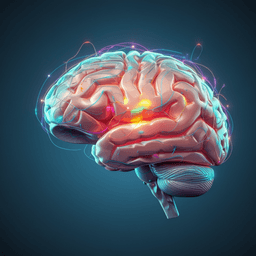
Psychology
Neural implementation of computational mechanisms underlying the continuous trade-off between cooperation and competition
M. A. Pisauro, E. F. Fouragnan, et al.
Explore the intricate dance between cooperation and competition in social interactions! This research by M. A. Pisauro, E. F. Fouragnan, D. H. Arabadzhiyska, M. A. J. Apps, and M. G. Philiastides unveils the 'Space Dilemma,' shedding light on how our brains navigate social dynamics and intention inference. Discover how neural mechanisms shape our cooperative choices!
~3 min • Beginner • English
Introduction
The study addresses how humans arbitrate along a continuous cooperation–competition spectrum rather than making binary cooperate/defect choices. Prior work has emphasized three determinants of cooperativeness in games with binary choices: environmental incentives (payoff structure), individual predispositions, and interactive dynamics such as reciprocity and trust. However, real-world social behavior involves graded degrees of cooperativeness that change over time. The authors pose two central questions: how do people decide their degree of cooperation or competition, and how do they adjust it dynamically given social context and a partner’s behavior? They hypothesize that social context biases choices, that individuals harbor social biases toward more or less cooperation, and that people update their behavior based on inferences about others’ intentions, potentially via Bayesian learning and social prediction error signals in regions implicated in social cognition (TPJ, mPFC, ACCg).
Literature Review
Past research shows that resource availability and distribution shape cooperation, with rich and fair environments promoting cooperation and scarcity/inequality fostering competition. Individual traits bias social orientation irrespective of payoffs, and reciprocity, trust, and reputation guide cooperative behavior in repeated interactions. Economic games manipulate environments via payoff matrices but people do not always reach equilibria predicted by standard theory. Social learning mechanisms, including monitoring others and mentalizing, employ prediction errors to update beliefs about partners. Bayesian models have captured biases and expectations in social tasks (e.g., advice trustworthiness, iterative games) and can formalize prediction-error-driven updates. Neuroimaging has implicated TPJ, mPFC, ACCg, and adjacent cingulate/paracingulate areas in processing others’ cooperative/competitive behavior and social prediction errors. Yet, how these regions encode context and Bayesian signals to guide graded cooperativeness remains unclear.
Methodology
Participants: Twenty-seven same-sex pairs (N=54; fMRI n=27 scanned; after exclusions N=25 dyads) from the University of Glasgow participant pool. One participant per pair was scanned; the partner played in an adjacent room. All were right-handed, with normal/corrected vision, no neurological/psychiatric history. Ethical approval obtained; informed consent provided. Behavioral session preceded fMRI; 81 in behavioral session; 54 in fMRI session. Pairs were unfamiliar; no deception used; order of conditions fixed (cooperation, competition, intermediate).
Task (Space Dilemma): On each trial, a target location on a 1D line was sampled from a uniform distribution. Each player viewed a moving bar traversing the space (4 s) and pressed a button to stop it at their chosen location, indicating their prediction of target position. After both responded, positions were revealed (1–1.5 s), then the target appeared (1.5 s). The closer player to the target won; reward magnitude scaled inversely with distance. Inter-trial interval: 2–2.5 s.
Social context manipulation: Reward distribution defined by parameter α controlling redistribution between winner and loser: R = (1 − min(d)). Per-trial allocation: R_win = α R; R_lose = (1 − α) R. Three blocks (60 trials each) per dyad:
- Cooperative (α=0.5): reward shared equally irrespective of winner.
- Intermediate (α=1): winner takes all; loser gets 0.
- Competitive (α=2): winner gets 2R; loser loses amount R from endowment.
Optimal dyadic efficiency involves spatial cooperation (occupying midpoints of hemifields), but incentives to compete differ by context.
Behavioral analyses: Linear mixed models tested effects of context on cooperativeness (distance from midpoint), inter-player distance, dyad reward, and trial-wise dynamics. Tit-for-tat (reciprocity) assessed by linking player’s next-trial change in position to co-player’s previous-trial change, binned by magnitude and direction (toward center=competition; away=cooperation).
Computational modeling: Eighteen models in three classes fitted to choices across contexts using maximum likelihood with Gaussian choice noise (Precision parameter):
- Simple reactive models (S1–S4): reciprocate last position/update; include SocialBias and TitXTat parameters.
- Bayesian models (B1–B8): Bayesian learner updates expectation over co-player’s cooperation θ via Gaussian prior (context-dependent: μprior=1 cooperation; 0.5 intermediate; 0 competition; σprior=0.05) and likelihood based on observed co-player variability; posterior expectation E[θ] informs choice, modulated by SocialBias, TitXTat, and context-dependent social risk (social risk = 2 − α) with sensitivity q_risk; some variants include target tracking or betrayal expectation.
- Reward models (R1–R6): update based on win/loss outcomes with Shift parameters, optionally including SocialBias and TitXTat.
Choice variable mapped to cooperation space θ = |x − 0.5|/0.5. Model comparison by BIC; parameter recovery performed via simulation.
Model-based regressors for fMRI: Social prediction error computed as KL divergence (KLD) between prior and posterior over co-player position each trial; unsigned magnitude (absPE) and signed direction (KLDsign: +1 if co-player more cooperative than expected; −1 if more competitive) used as parametric regressors.
fMRI acquisition: 3T Philips Achieva; EPI (TR=1.5 s; TE=40 ms; 40 slices; 3×3×3 mm; flip angle 80°); 3 runs (≈450 volumes each; 60 trials per block). T1 MPRAGE (1 mm isotropic). B0 map acquired.
Preprocessing: Motion correction, slice-timing correction, high-pass filtering (>100 s), spatial smoothing (8 mm FWHM), distortion correction; registration to MNI space. Analyses in FSL FEAT with mixed-effects (FLAME 1+2). Cluster inference Z>3.1, cluster-level FWE P<0.05 unless otherwise noted.
GLMs:
- GLM1: Event regressors at trial onset, self response, opponent response (with parametric modulators: absPE and signPE), target onset (with reward and win/lose modulators), and prior expected co-player position at trial onset; self cooperation change at response. Analyses across and between contexts (cooperative vs competitive).
- GLM2: Boxcar covering trial duration; context contrasts.
- GLM3: Replaced PE parametrics with four bins (high/low positive, high/low negative) to test full parametric effects in TPJ ROIs.
ROI/time-course analyses examined predictive power of signals for behavior on trial t+1; correlations with model parameters (SocialBias, TitXTat).
Key Findings
Behavioral:
- Social context significantly reduced average cooperativeness (greater competition) as α increased: β = −0.12, P<0.001 (LMM on average cooperativeness); reduced absolute distance between players: β = −0.25, P<0.001; dyad total reward decreased with more competitive contexts: β = −2.41, P<0.05; no significant effect on individual reward: β = −1.16, P = 0.26.
- Dynamics: In cooperative context, players maintained cooperative positions with mild drift toward optimal locations over time (p=0.00086; P=0.03 effect of trial on inter-player distance). In intermediate context, gradual convergence toward center (β=−0.01, P<0.005). Competitive context showed closer-to-midpoint (competitive) positions maintained.
- Tit-for-tat reciprocity: Players reciprocated co-player’s previous change; larger co-player changes induced larger reciprocal changes (β=0.03, P<0.001). Context modulated reciprocity, less pronounced in competitive context (interaction β=−0.015, P<0.001).
Computational modeling:
- Bayesian models outperformed simple reactive and reward-based models (BIC). Regression showed Bayesian expected positions predicted choices better than last observed positions.
- Winning model: B6 (Bayesian). Key parameters: Precision, SocialBias (inherent pro/anti-social bias), TitXTat (reciprocity strength), q_risk (sensitivity to context-dependent social risk = 2 − α). TitXTat normalized by social risk so reciprocity decreased as competitive risk increased. Anti-correlation observed between SocialBias and TitXTat across contexts, indicating a trade-off between prosocial bias and tit-for-tat behavior.
Neuroimaging:
- Right TPJ encodes social prediction error components at opponent response:
• Unsigned PE (KLD magnitude) in posterior rTPJ (prTPJ): Z=4.40; MNI x=52, y=−58, z=30.
• Signed PE (KLD sign) in anterior rTPJ (arTPJ): peak Z=−3.67; MNI x=50, y=−38, z=32. Both clusters survived whole-brain cluster correction (Z>3.1; P<0.05).
• Additional unsigned PE magnitude responses: IFG (50,16,14), MFG (44,16,40), bilateral Insula (±34,22,−4), Middle Temporal Gyrus (56,−30,−10 / 60,4,−24).
• ROI/GLM3 binning: prTPJ showed U-shaped responses scaling with PE magnitude; arTPJ increased with prediction errors signaling increased competition by co-player.
• arTPJ activity predicted future behavioral change (trial t+1) in intermediate context (P<0.001), indicating a role in guiding updates in cooperativeness.
- Context modulation of updating signals:
• Posterior dorsomedial PFC extending to pre-SMA and cingulate (pDMPFC; Z=−4.09; MNI x=−8, y=16, z=52) encoded self changes in cooperation differently across cooperative vs competitive contexts at decision time. Additional context effects in SFG (Z=−3.54; 28,6,56), right Insula (Z=−3.85; 30,26,0), Precuneus (Z=−3.95; −6,−56,56).
• ACC gyrus (ACCg; Z=−3.13; 0,34,20) and paracingulate cortex (PaCg; Z=−3.36; 2,50,12) encoded the sign of social PE with context-dependent polarity: positively signaling increases in co-player cooperation in the competitive context but negatively in the cooperative context. Both regions’ activity predicted future changes (t+1) in competitiveness in intermediate and competitive contexts (P<0.001), biasing toward increased cooperation in intermediate and increased competition in competitive contexts.
• Correlations with model parameters: Representation of self increases in cooperation in ACC/PaCg positively correlated with SocialBias and negatively with TitXTat; evidence for a rostro-caudal self–other gradient within ACC.
Overall, TPJ subregions dissociate unsigned vs signed social PEs, with arTPJ signals predicting behavioral updating, while medial frontal/cingulate regions encode context-dependent updating for self and other and relate to individual differences in social bias and reciprocity.
Discussion
Findings show that human cooperative vs competitive behavior unfolds along a continuum shaped by environmental incentives (payoff redistribution), intrinsic social biases, and online inferences about a partner’s intentions. Behavior followed a tit-for-tat strategy but relied on Bayesian expectations that integrate partner history rather than reactive responses to the last action, explaining robust reciprocity to larger deviations and context-dependent modulation. The winning Bayesian model (B6) formalizes this process, with social risk scaling reciprocity and individual SocialBias shifting baseline cooperativeness.
Neurally, rTPJ tracked social prediction errors central to updating beliefs about others: prTPJ encoded unsigned surprise to another’s competitiveness/cooperativeness, while arTPJ encoded the directional discrepancy, and critically, arTPJ signals predicted subsequent behavioral adjustments when variability was highest (intermediate context). Medial frontal, cingulate, and paracingulate regions encoded how social context shaped both self updates and monitoring of others, with ACCg and PaCg flexibly inverting their responses to cooperative shifts depending on whether the environment incentivized cooperation or competition, and their trial-wise activity predicted future adjustments. Correlations between these neural signals and model parameters link brain activity to individual differences in social bias and reciprocity strength. Together, results provide a computational–neural account of how social context and inferences regulate continuous shifts between cooperation and competition.
Conclusion
This study introduces the Space Dilemma, a continuous economic game that generalizes the Prisoner’s Dilemma to capture graded cooperativeness. Behavior is best described by a Bayesian learner integrating social context, inherent social bias, and partner-informed reciprocity. rTPJ subregions dissociate unsigned and signed social prediction errors, with arTPJ predicting future behavioral updates. Medial frontal, cingulate, and paracingulate cortices encode context-dependent updates for self and other and relate to individual differences in social bias and tit-for-tat tendencies. These findings elucidate computational and neural mechanisms governing the continuous trade-off between cooperation and competition. Future work can vary uncertainty (non-uniform target distributions), task difficulty (timing constraints), and social structure (more players, alternative reward distributions) to probe generalization and causal mechanisms.
Limitations
- Fixed order of social contexts (cooperation → competition → intermediate) may introduce order or carryover effects, limiting causal attribution purely to context.
- Sample comprised same-sex dyads and a modest fMRI sample size after exclusions, potentially constraining generalizability.
- One participant per dyad was scanned, limiting simultaneous inter-brain inferences.
- fMRI is correlational; causal roles of identified regions were not tested (e.g., via brain stimulation or lesion studies).
- Task used uniform target distributions and specific payoff parametrizations; findings may differ with other uncertainty structures or incentives.
- The Space Dilemma abstracts real-world interactions; ecological validity to complex social environments warrants further testing.
Related Publications
Explore these studies to deepen your understanding of the subject.







